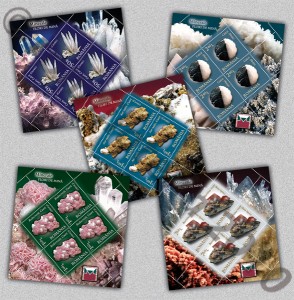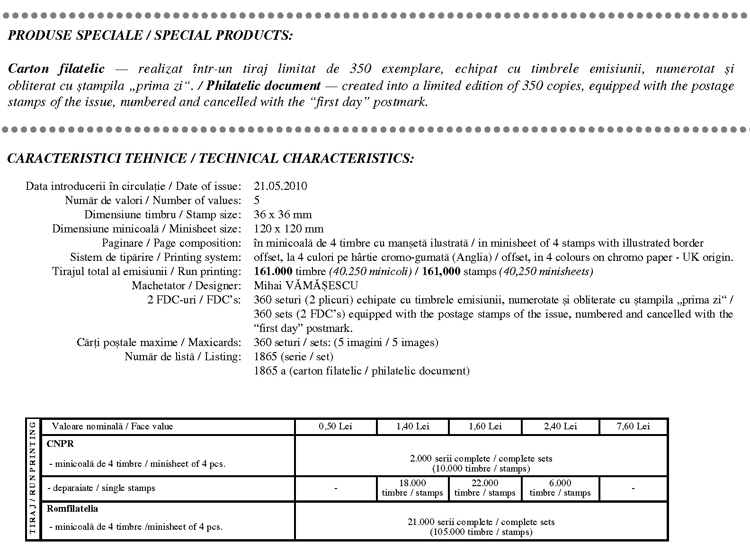 Taking into consideration the patrimony value of the unique exhibits from the Mineralogical Museum of Baia Mare, the biggest regional museum in this field from Europe and in order to bring into prominence the beauty and the value of these exhibits, Romfilatelia introduces into circulation the postage stamps issue “MINERALS – Crystal clusters”.Taking into consideration the patrimony value of the unique exhibits from the Mineralogical Museum of Baia Mare, the biggest regional museum in this field from Europe and in order to bring into prominence the beauty and the value of these exhibits, Romfilatelia introduces into circulation the postage stamps issue “MINERALS – Crystal clusters”.
Taking into consideration the patrimony value of the unique exhibits from the Mineralogical Museum of Baia Mare, the biggest regional museum in this field from Europe and in order to bring into prominence the beauty and the value of these exhibits, Romfilatelia introduces into circulation the postage stamps issue “MINERALS – Crystal clusters”.Taking into consideration the patrimony value of the unique exhibits from the Mineralogical Museum of Baia Mare, the biggest regional museum in this field from Europe and in order to bring into prominence the beauty and the value of these exhibits, Romfilatelia introduces into circulation the postage stamps issue “MINERALS – Crystal clusters”.
The mineral is a solid body with a certain chemical composition that is found in nature in crystalline or amorphous state, separately or in the structure of rocks and ores.
As one of the nature’s wonders, minerals may be found as crystals in the depths of the earth. The ones who discovered them, namely the miners, called crystal clusters the most beautiful of them.
The crystal cluster is a mineral sample gathered from the underground, a monomineral or made of several minerals having special esthetic qualities due to intergrowth of mineral crystals, colours, shapes (habitus), exceptional sizes of some component crystals, qualities taken as a whole, make each sample be unique among the others.
Quartz, calcite is the crystal cluster illustrated on the postage stamp with the face value of RON 0.50. Quartz (SiO2) is the most frequent mineral in nature and can be found in various shapes. Transparent by definition, quartz may have different colours, milky white being the most common one. The aggregate from Cavnic Mine is one of the most spectacular crystal made of crystals radically intergrown, very long, with transparent and perfect peaks (sample size: 21/7/25 cm).
Free gold, quartz is illustrated on the postage stamp with the face value of RON 1.40. Gold (Au) belongs to the group of free elements (free metal) and it rarely comes in combinations. The crystal cluster presented has been discovered in Cavnic Mine and is made of bright yellow thin sheets and capillaries having the general aspect of moss, in paragenesis with small white quartz crystals (sample size: 8/7/5 cm).
Rhodochrosite, quartz is the sample illustrated on the postage stamp with the face value of RON 1.60. Rhodochrosite (MnCO3), from the carbonate class, is rarely found in the world as crystals. The well-developed intense pink rhombohedra sample from Cavnic Mine is one of the most representatives (sample size: 10/5/4 cm).
Calcite (CaCO3), illustrated on the postage stamp with the face value of RON 2.40, is a mineral also from the carbonate class. Encountered frequently in nature, calcite has thousands of crystallographic shapes and different colors: white, yellowish, pink, brown etc. The perfect round and black-colored shapes appear very seldom due to the boulangerite inclusions. The spherical aggregate in the picture, made by the juxtaposition of black and white flat rhombohedra equally splitting the sample, is the sole exemplar in the world found at Herja Mine (sample size: diameter 8 cm).
Red barite (BaSO4), illustrated on the postage stamp with the face value of RON 7.60, is a mineral from the sulphate class. Hydrothermally formed, it appears in tabular transparent crystals of diverse colours: white, yellow, brown and blue. The rarest and most unusual colour for barite is red, the samples with large individual crystals being unique in the world and they may be seen only at Baia Sprie Mine (sample size: 18/16/10 cm, crystal size 5 cm).
Ruby sulphur (As4S4), illustrated on the “first day” cover (FDC), is a mineral made of arsenic and sulphur from the sulphide and sulphosalts class. Its name comes from the Arabian language – Radj al ghar – meaning cave powder. The bright red colour of crystals on the white quartz background but especially its size and perfection and its placing in the assembly of the piece makes the sample discovered at Baia Sprie Mine be the most spectacular of all (sample size: 10/9/5 cm).
We kindly thank to the Mineralogical Museum of Baia Mare for the photos put at our disposal through the good will of prof. Victor Gorduza, the founding manager of the museum and photographer Valentin Ganta, for their support in the accomplishment of this postage stamps issue.
Issue date: 2010-05-21
















